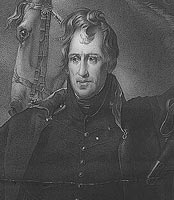|

|
The 1828 Campaign of Andrew Jackson and the Growth of Party Politics
—Curriculum Overview—
The triumph of Andrew Jackson marked the end of the old era of trained statesmen for the Presidency. With him began the era of the popular hero.
—Frederick Jackson Turner, The Frontier in American History
Introduction
Changes in voting qualifications and participation, the election of Andrew Jackson, and the formation of the Democratic Party—due largely to the organizational skills of Martin Van Buren—all contributed to making the election of 1828 and Jackson's presidency a watershed in the evolution of the American political system. The campaign of 1828 was a crucial event in a period that saw the development of a two-party system akin to our modern system, presidential electioneering bearing a closer resemblance to modern political campaigning, and the strengthening of the power of the executive branch.
In this unit, students analyze changes in voter participation and regional power, and review archival campaign documents reflecting the dawn of politics as we know it during the critical years from 1824 to 1832.
Guiding Questions
- How did changes in the electorate affect the election of 1828?
- How were party politics reflected in the campaign of 1828?
- What was the source of Andrew Jackson's popularity?
- What was the importance of Andrew Jackson's popularity?
- What were the positions of the fledgling Democratic Party and its opposition?
Learning Objectives
After completing the lessons in this unit, students will be able to:
- Give examples to indicate how the franchise was extended in the first half of the 19th century.
- Discuss possible effects of the extension of the franchise on the election of 1828.
- Make a connection between changes in voting participation and the election of 1828.
- Describe regional factors evidenced by the voting results in the election of 1828.
- Analyze campaign materials from 1828.
Preparing to Teach This Curriculum Unit
- Review each lesson plan. Locate and bookmark suggested materials and other
useful websites. Download and print out documents you will use and duplicate
copies as necessary for student viewing.
- Download the blackline
masters for this lesson, available here as a PDF file. Print out and make
an appropriate number of copies of any handouts you plan to use in class.
- This unit is one of a series of complementary EDSITEment lessons on the
early growth of political parties in the United States. Some student knowledge
of the events and issues covered in the following complementary lessons is
essential to a complete understanding of the presidential election of 1828.
- The Growth
of Political Parties covers such issues and events as the negative attitude
among the Founders toward political parties, as reflected in Washington's
Farewell Address; the differences in philosophy and policy between followers
of Thomas Jefferson and James Madison (who favored a less active federal
government and eventually formed the Democratic-Republican Party) and the
followers of Alexander Hamilton (who espoused a more powerful and active
federal government and eventually formed the Federalist Party).
- Certain
Crimes Against the United States: The Sedition Act deals with—among
other issues and events—foreign affairs during the Federalist presidency
of John Adams, and the political differences that contributed to the creation
of the Sedition Act, which led, in turn, to the demise of the Federalist
Party.
- The Election
Is in the House: The Presidential Election of 1824 touches on events
in the presidential campaign of 1824, in which every candidate belonged
to the Democratic-Republican Party, throwing the election into the House
of Representatives, and thus setting the stage for the election of 1828.
The lesson also discusses the Electoral College and the procedure to be
used when an election is thrown into the House of Representatives.
- The first three lessons in this unit look at different aspects of the changes
in the electorate that were occurring in the first half of the 19th century.
With that background, students are better prepared to study the election campaign
of 1828 in the final lesson. It is also important for students to have some
knowledge of the controversial election of 1824. For relatively brief yet
comprehensive background on the election of 1824 and the election of 1828
and its aftermath, read the following one-page articles from Digital
History, a project of the Gilder
Lehrman Institute of American History, a link from the EDSITEment-reviewed resource
History Matters:
If time permits, some students would benefit from the background gained
through reading the essays as well.
- Throughout this unit, but especially in the culminating activity for Lesson
Four, below, students read and analyze a variety of primary documents.
The following materials from EDSITEment-reviewed resources may be useful to teachers
seeking expert advice on the use of primary documents:
Unit Lessons
Selected EDSITEment Websites
Standards Alignment
View your state’s standards
|





